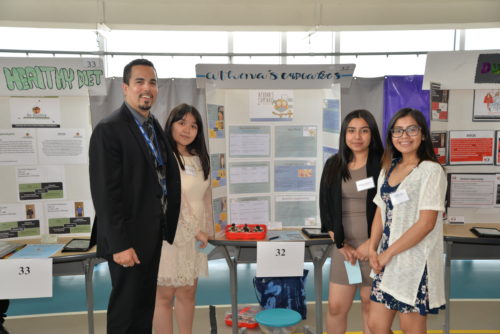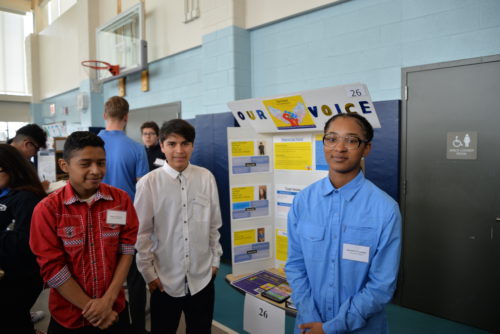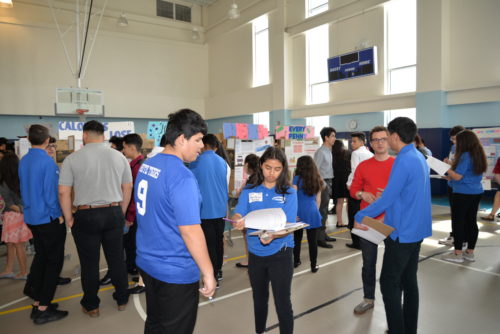Features
Entrepreneurship teacher helps high school freshman develop mobile apps to meet community needs
Posted on: November 11, 2019

Benjamin Franklin. Steve Jobs. Mark Zuckerberg. Travis Kalanick. Garret Camp. Reed Hastings. These men have changed society through the implementation of their ideas and represent some of the most prominent entrepreneurs.
Thanks to the flexibility charter public schools have in developing unique curriculums, students at ASPIRA Business & Finance High School are able to study entrepreneurship before college. From freshman to senior year, students cultivate entrepreneurial mindsets, write original business plans with income projections, code mobile apps, and create digital portfolios using professional tools like Photoshop and Dreamweaver.
Below is a conversation INCS had with Bernadette Medina, one of ASPIRA’s teachers, about Chicago’s teenage entrepreneurs.
INCS: Entrepreneurship teacher is a unique position to hold. How did you arrive at this position? Did you study entrepreneurship in college? Do you consider yourself an entrepreneur?
Bernadette Medina: My passion was graphic design. When I started with Aspira fifteen years ago, I was doing web design and graphic design with the students. After a couple of years, I moved to a different school in the network, and their main focus was business. So, I learned from training myself. We have a program called NFTE (Network for Teaching Entrepreneurship), which provides all of the entrepreneurship lessons. I was put into that position without knowing anything, which turned out to be a good thing. I learned by reading the lessons NFTE provided. It made me more aware of what entrepreneurship was, and it was a pretty cool curriculum. Students were able to become entrepreneurs, have an entrepreneurial mindset, and develop their own business idea. I thought that was fascinating.
What have you learned through the process of learning to be and working as an entrepreneurship teacher? Does it intersect at all with some of your graphic design skills?
Entrepreneurship aligns with graphic design. Right now, I’m teaching a startup tech business entrepreneurship program where students are able to develop a mobile app and code it. My background is also in programming, which aligned with both business and graphic design. Students create different types of logos, flyers, and content for their mobile applications. This program opened my mind to how entrepreneurship utilizes both graphic design and programming skills.
 In the course of a year, what does an entrepreneurship course look like? What do you hope students take away from the class?
In the course of a year, what does an entrepreneurship course look like? What do you hope students take away from the class?
In my class, Start-Up Tech, students are trying to build something that the community needs. Using the MIT App Inventor, they can develop any idea that they have, as long as it solves a community need. They first learn about business terminology. After that, they learn how to start creating apps through the MIT App Inventor. Then they’re put in groups and have to present in a big, schoolwide expo that showcases their apps and includes any type of marketing materials they have. It’s called the Startup Tech Showcase. At the end of the year, they showcase all of these items with their team, the app they developed, and all of the business plan components. This will be our fifth year doing the showcase.
Can you give us an example of an app students created that filled a community need?
Some of the community needs are related to healthcare, the environment and business. Many students have created recycling apps, medical apps, cupcake businesses, games, clothing line and beauty apps.
How have students responded to learning about entrepreneurship? Have you received any feedback from a student who has created a mobile app?
At first, when students start creating their apps, they tend to tense up. They have a hard time doing it, but by the end of the course you can see their progression from when they first started. At the end, it’s nice to see they’re able to showcase their apps. Another thing we focus on is presentation skills. Because I deal with freshmen, students start out very timid, but by the end they come alive and are all about their apps. They’re driven. They can explain their apps. It’s nice to see their development throughout the course.
 Even if students don’t go on to become full-time entrepreneurs, can you talk to INCS about the skillset students are developing that could be helpful in other, non-business pursuits?
Even if students don’t go on to become full-time entrepreneurs, can you talk to INCS about the skillset students are developing that could be helpful in other, non-business pursuits?
Through our program, students gain computer science skills and word processing skills. They learn how to email and send information in a professional manner. They learn how to use Powerpoint and Excel. These are some of the main skills they develop, along with presentation skills such as: how to talk to someone; and how to pitch an idea.
Is there anything we haven’t discussed that you’d like to add?
My kids are amazing. Last year, I had seniors graduate who I taught since freshman year. It’s nice to see their progression throughout the years and their growth in confidence when it comes to their business ideas. It was nice to see the students still implementing ideas they had since freshman year. Now, I have freshmen again. Getting to see another set of students’ progress will be beneficial to me. I’ve truly loved this program because it showcases what the students love. It shows what they want to be and do when they get a little bit older, even if it has nothing to do with business.
To learn more and support students at ASPIRA, visit https://www.aspirail.org/index.jsp.